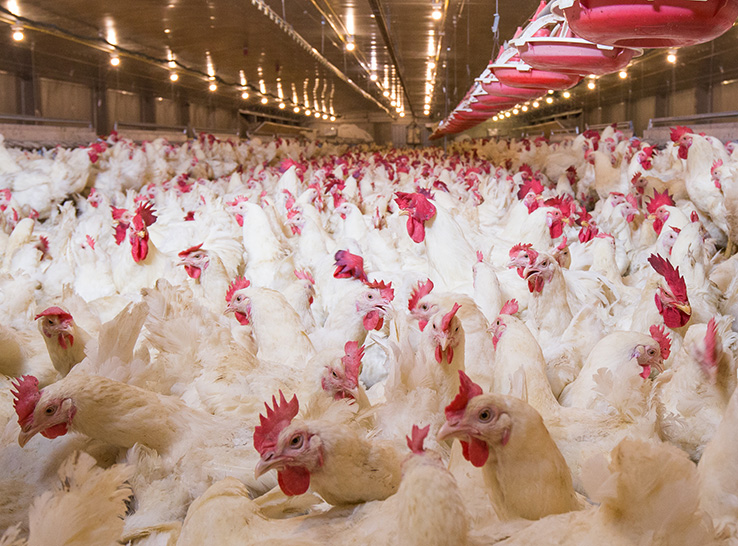Avian metapneumovirus (aMPV) has swept through production facilities across the US since its initial appearance in late 2023. aMPV infections can result in mass morbidity, significant egg drops and, in the most severe cases, mortalities.
The virus is significantly impacting chicken and turkey production in the country, necessitating improvements in early detection, biosecurity and effective vaccination, according to a panel of industry experts who spoke at an American Association of Avian Pathologists event on the current aMPV outbreak.
No vaccines are currently available against the pathogen, but this needs to change, explained Holly Sellers, PhD, professor at the University of Georgia’s Poultry Diagnostic and Research Center.
“This is certainly a time when we need to have the ability to import live attenuated vaccines that have been used successfully in Europe and South America,” she told an audience at the event.
“aMPV is one serotype, and our colleagues have demonstrated that they’ve had very good protection using one or the other [commercial vaccines] to control the disease. I don’t think we need to recreate the wheel here.
“Now that we have isolates in our lab and other labs as well, autogenous vaccines may also be an option,” she said.
Virus changes threaten vaccine efficacy
Sunil Mor, PhD, assistant professor at the Animal Disease Research and Diagnostic Laboratory at South Dakota State University, has demonstrated through his research that the type B of the virus currently circulating is a separate sublineage to what came before, with one strain infecting chickens and turkeys.
His team has also identified 24 to 44 amino acid substitutions in the G protein of the virus, which is a vaccine-antigen candidate, compared to previous strains in the US. This finding throws doubt on whether available commercial live vaccines would be effective against current strains. He pointed to Italian research comparing a 2007 strain of aMPV to recent virus isolations, which found that the current virus had 18 amino acid substitutions and resulted in vaccines being unable to provide sufficient protection.
“If we correlate this information with the data we have, with 24 or more amino acid substitutions, it may be suspected that the commercially available live vaccines may not provide protection if we wanted to import them,” he said.
“But this is just based on the sequence analysis. In vivo studies will give us more confidence and a better confirmation whether the vaccines will cross-protect against these new emerging subgroup A and B viruses here in the US,” Mor added.
Secondary infections complicate picture
Dallas Clontz, DVM, from Veterinary Diagnostic Pathology, LLC, shed light on how infection progresses in birds.
“Some experimental studies have reported complete deciliation of the trachea in 96 hours post-infection with some European strains, which include A and B. That’s an important part of the pathogenesis, because once we lose the cilia, we lose our major ciliary escalator, and that opens the door for secondary infection,” she explained.
She pointed out that the infection initially presents as an uncomplicated viral infection with mild inflammation. But when immunity is impaired, secondary infections take over and cause more serious lesions. Among these more serious effects, she noted that damage to the oviduct may cause egg drop in laying birds.
Early diagnosis issues
The experts agreed that initial diagnosis of aMPV infections was difficult. Early cases often confounded veterinarians for some time, in part due to clinical signs resembling those of other respiratory conditions, Sellers explained. Additionally, both viral and bacterial coinfections complicated the picture. Moreover, the virus has a relatively short window of replication, she added.
Molly Parker, DVM, of Select Genetics, spoke from her professional experience, noting that aMPV proved almost impossible to recognize on clinical signs alone.
“I’ve learned that aMPV can do whatever it wants to do, as far as clinical presentation,” she said. The rapid spread witnessed at the farms she works on would mean that “if I had to do it all over again, I would just kind of sit back and let it blow through.”
In addition to early diagnosis challenges, Parker’s team encountered another early roadblock — the aMPV tests were often looking for type C of the virus, not the types A and B that were circulating.
The researchers and veterinarians agreed that multiplex PCR testing, which tests for types A and B simultaneously, is effective as a diagnostic tool.
The speakers also agreed that biosecurity needs to be readdressed in light of the outbreak.
“I feel strongly that our traditional biosecurity methods don’t work on this disease…I think there are multiple ways in which it spreads around. For example, all the lay farms were struggling the day after a storm, so I think there is an aerosol component to this as well,” Parker said.
Making sense of evolving outbreak
The poultry scientists identified several trends with infections on their farms. These trends are part of the local knowledge that adds to an overall understanding of the outbreak.
They presented evidence that susceptibility to the virus could vary by breed and also that infections later in birds’ lives could result in more severe mortality.
On the farms where Parker works, the virus has been found in layer and stud flocks, and disease in six layer farms was linked to one stud farm. However, only the layers showed signs of disease. She believes the male birds play a role in transmission, though her investigations to date have not confirmed this.
“I’ve tested a lot of semen and I consistently get negatives,” she reported, suggesting that this could be because testing comes too late for it to show up.
“The studs, for whatever reason, don’t tend to show a lot of signs. As to how aMPV is being transmitted, it could be some other fomite touching the bird and the semen vial, or it could be something within the process that is not the semen itself.”
With the picture changing fast, effective communication of the latest knowledge breakthroughs has been critical as the outbreak develops.
“There’s been a lot of sharing of information. It’s been the perfect example of how we work best in our industry,” Sellers added.









